
June 1942 Crete airfield raids
Encyclopedia
Operation Albumen was the name given to British Commando raids in June 1942, on German airfields in the Axis-occupied Greek island of Crete
, to prevent them from being used for supporting the Afrika Korps
in the Western Desert Campaign
in World War II
. These operations were carried out in tandem with similar raids against Axis airfields at Benghazi, Derna and Barca in Libya and were among the very first planned sabotage
acts in occupied Europe.
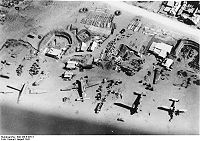 During the late spring of 1942, the airfields of Crete gained increased strategic importance by becoming the main transit base for Luftwaffe
During the late spring of 1942, the airfields of Crete gained increased strategic importance by becoming the main transit base for Luftwaffe
to supply logistic support to Rommel's
Afrika Korps
in their advance on the Nile Delta
. Furthermore, Luftwaffe aircraft based on Crete operated photo-reconnaissance, bombing and convoy attack missions covering the south-east Mediterranean
region. Aiming to disrupt these operations, British generals in Cairo
sent to Crete three groups from the Special Boat Squadron
(SBS) and one from Stirling's
Special Air Service
(SAS) with the mission to sabotage the airfields of Heraklion, Kastelli Pediados, Tympaki
and Maleme
.
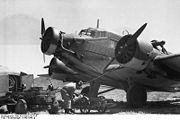 Aircraft types operating from Crete at the time included the Ju 52
Aircraft types operating from Crete at the time included the Ju 52
and Me 323
for transport, the Ju 88
and Ju 86
for bombing and photo-reconnaissance and the Bf 109
as a fighter.
Heraklion airfield was allocated to the SAS group whereas the SBS groups were assigned to the other three airfields. The SBS groups were met by Tom Dunbabin
, the British liaison officer with the Cretan resistance
, who provided them with local guides. The date for all sabotages was scheduled as the night of the 7th and 8th of June, 1942.
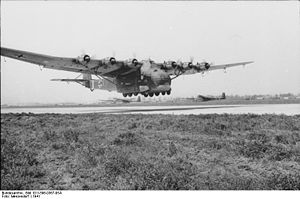 The squad to attack Kastelli consisted of Irish captain G.I.A. Duncan of the Black Watch
The squad to attack Kastelli consisted of Irish captain G.I.A. Duncan of the Black Watch
, two British NCO
s of the SBS and the Greek gendarme
Vassilis Dramoundanis. The operation unfolded according to plan and on June 7, the saboteurs assisted by the locals Giorgos Psarakis, Kimonas Zografakis and Kostas Mavrantonakis, managed to destroy 5 aircraft, damage 29 other and arson several vehicles and considerable quantities of supplies (including about 200 tons of aviation fuel) using delayed action bombs.
The June 1942 operation is often referred to as the first raid on Kastelli to differentiate it from a second, similar operation that took place a year later. One of the objectives of this second operation was to lead the Germans into believing that an Allied landing on Crete (rather than their true target Sicily
) was imminent. Thus, on the night of July 4 to July 5 1943, two commando groups under the Danish major
Anders Lassen
and the Greek Kimonas Zografakis, simultaneously attacked the airfield of Kastelli from two different locations. Despite the strong security, they succeeded in deceiving the garrison and destroying most of the parked aircraft and fuel dumps.
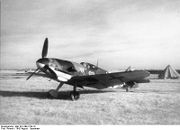
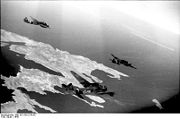 The Heraklion operation was commanded by George Jellicoe
The Heraklion operation was commanded by George Jellicoe
and included four members of the Free French Forces
under Georges Bergé (the other three being Jacques Mouhot, Pierre Léostic and Jack Sibard) and lieutenant
Kostis Petrakis of the Hellenic Army
. Things went out of plan for the party of six saboteurs which were transferred to Crete on board the Greek submarine Triton: rowing in three inflatable boat
s, they set ashore in the Gulf of Malia on the dawn of June 10, further east from the intended Karteros beach and behind schedule. Spending the days hiding and the nights marching, they reached Heraklion airfield on the night of 12 to 13 of June. However, they were unable to mount an assault due to the increased traffic caused by a succession of night sorties that was in progress. Eventually, the attack took place on the night of June 13, when the group managed to enter the area of the airfield while it was being bombed by the RAF
. In total, about 20 aircraft (Ju 88) were destroyed using Lewes bomb
s. While all six saboteurs managed to escape from the airfield, their retreat was betrayed resulting in 17-yr old Pierre Léostic being killed and the other three French being arrested. Jellicoe and Petrakis managed to escape to Egypt.
) discovered that due to air raids from Egypt, the airfield had been temporarily abandoned and the aircraft based there had been relocated.
to the sabotage in Heraklion, the occupation forces executed 50 inhabitants of the greater Heraklion area on the next day, June 14. A few days earlier (June 3), the Germans had executed another 12 Heraklion citizens. The Avenue of the 62 Martyrs in modern Heraklion
is named in remembrance of the victims.
On June 23, Jellicoe, Petrakis and the participants of the Kastelli and Tympaki operations were evacuated to Mersa Matruh, Egypt
on a caique
from Trypiti beach near the village of Krotos
in south Crete. They reached Mersa Matruh shortly before it fell to Rommel's advancing forces. Jellicoe was later awarded the DSO
. After several days of interrogations under the threat of execution, Bergé, Mouhot and Sibard who were captured after the Heraklion sabotage, were transferred to the Oflag X-C
war prisoner camp in Germany. Eventually,
Bergé ended up in Colditz
castle, the Saxon fortress where prisoners that had repeatedly attempted to escape were held. There, Bergé joined SAS commander David Stirling
who had been captured in the mean time. To honor the memory of Pierre Léostic, Kostis Petrakis christened
his son after him.
The failure to prevent the raids on the airfields was one of the reasons that led to the
replacement of General Alexander Andrae
by Bruno Bräuer
as commander of Crete.
Crete
Crete is the largest and most populous of the Greek islands, the fifth largest island in the Mediterranean Sea, and one of the thirteen administrative regions of Greece. It forms a significant part of the economy and cultural heritage of Greece while retaining its own local cultural traits...
, to prevent them from being used for supporting the Afrika Korps
Afrika Korps
The German Africa Corps , or the Afrika Korps as it was popularly called, was the German expeditionary force in Libya and Tunisia during the North African Campaign of World War II...
in the Western Desert Campaign
Western Desert Campaign
The Western Desert Campaign, also known as the Desert War, was the initial stage of the North African Campaign during the Second World War. The campaign was heavily influenced by the availability of supplies and transport. The ability of the Allied forces, operating from besieged Malta, to...
in World War II
World War II
World War II, or the Second World War , was a global conflict lasting from 1939 to 1945, involving most of the world's nations—including all of the great powers—eventually forming two opposing military alliances: the Allies and the Axis...
. These operations were carried out in tandem with similar raids against Axis airfields at Benghazi, Derna and Barca in Libya and were among the very first planned sabotage
Sabotage
Sabotage is a deliberate action aimed at weakening another entity through subversion, obstruction, disruption, or destruction. In a workplace setting, sabotage is the conscious withdrawal of efficiency generally directed at causing some change in workplace conditions. One who engages in sabotage is...
acts in occupied Europe.
Overview

Luftwaffe
Luftwaffe is a generic German term for an air force. It is also the official name for two of the four historic German air forces, the Wehrmacht air arm founded in 1935 and disbanded in 1946; and the current Bundeswehr air arm founded in 1956....
to supply logistic support to Rommel's
Erwin Rommel
Erwin Johannes Eugen Rommel , popularly known as the Desert Fox , was a German Field Marshal of World War II. He won the respect of both his own troops and the enemies he fought....
Afrika Korps
Afrika Korps
The German Africa Corps , or the Afrika Korps as it was popularly called, was the German expeditionary force in Libya and Tunisia during the North African Campaign of World War II...
in their advance on the Nile Delta
Nile Delta
The Nile Delta is the delta formed in Northern Egypt where the Nile River spreads out and drains into the Mediterranean Sea. It is one of the world's largest river deltas—from Alexandria in the west to Port Said in the east, it covers some 240 km of Mediterranean coastline—and is a rich...
. Furthermore, Luftwaffe aircraft based on Crete operated photo-reconnaissance, bombing and convoy attack missions covering the south-east Mediterranean
Mediterranean Sea
The Mediterranean Sea is a sea connected to the Atlantic Ocean surrounded by the Mediterranean region and almost completely enclosed by land: on the north by Anatolia and Europe, on the south by North Africa, and on the east by the Levant...
region. Aiming to disrupt these operations, British generals in Cairo
Cairo
Cairo , is the capital of Egypt and the largest city in the Arab world and Africa, and the 16th largest metropolitan area in the world. Nicknamed "The City of a Thousand Minarets" for its preponderance of Islamic architecture, Cairo has long been a centre of the region's political and cultural life...
sent to Crete three groups from the Special Boat Squadron
Special Boat Service
The Special Boat Service is the special forces unit of the British Royal Navy. Together with the Special Air Service, Special Reconnaissance Regiment and the Special Forces Support Group they form the United Kingdom Special Forces and come under joint control of the same Director Special...
(SBS) and one from Stirling's
David Stirling
Colonel Sir Archibald David Stirling, DSO, DFC, OBE was a Scottish laird, mountaineer, World War II British Army officer, and the founder of the Special Air Service.-Life before the war:...
Special Air Service
Special Air Service
Special Air Service or SAS is a corps of the British Army constituted on 31 May 1950. They are part of the United Kingdom Special Forces and have served as a model for the special forces of many other countries all over the world...
(SAS) with the mission to sabotage the airfields of Heraklion, Kastelli Pediados, Tympaki
Tympaki Airport
Tympaki Airport is a military airport in Tympaki, Crete, Greece. It has also been used for car racing but it belongs to the Hellenic Air Force.The 138 Σ.Μ of H.A.F. operates at the airport. The airport also has a TACAN system for the aircraft.The airport used to have another runway but now it's...
and Maleme
Maleme Airport
Maleme Airport is an airport situated at Maleme, Crete. It has two runways & with no lights. The airport is closed for commercial aviation but it's used by Chania Aeroclub. The airport operated until 1959 as the main public airport of Chania. Today the use from the Hellenic Air Force is limited...
.

Junkers Ju 52
The Junkers Ju 52 was a German transport aircraft manufactured from 1932 to 1945. It saw both civilian and military service during the 1930s and 1940s. In a civilian role, it flew with over 12 air carriers including Swissair and Deutsche Luft Hansa as an airliner and freight hauler...
and Me 323
Messerschmitt Me 323
The Messerschmitt Me 323 Gigant was a German military transport aircraft of World War II. It was a powered variant of the Me 321 military glider and was the largest land-based transport aircraft of the war...
for transport, the Ju 88
Junkers Ju 88
The Junkers Ju 88 was a World War II German Luftwaffe twin-engine, multi-role aircraft. Designed by Hugo Junkers' company through the services of two American aviation engineers in the mid-1930s, it suffered from a number of technical problems during the later stages of its development and early...
and Ju 86
Junkers Ju 86
The Junkers Ju 86 was a German monoplane bomber and civilian airliner designed in the early 1930s, and employed by both sides during World War II. The civilian model Ju 86B could carry 10 passengers. Two were delivered to Swissair and five to Luft Hansa...
for bombing and photo-reconnaissance and the Bf 109
Messerschmitt Bf 109
The Messerschmitt Bf 109, often called Me 109, was a German World War II fighter aircraft designed by Willy Messerschmitt and Robert Lusser during the early to mid 1930s...
as a fighter.
Heraklion airfield was allocated to the SAS group whereas the SBS groups were assigned to the other three airfields. The SBS groups were met by Tom Dunbabin
Thomas James Dunbabin
Thomas James Dunbabin DSO , was an Australian classicist scholar and archaeologist of Tasmanian origin. His father was , a distinguished journalist. Dunbabin studied at the University of Sydney and then moved to Corpus Christi College, Oxford...
, the British liaison officer with the Cretan resistance
Cretan resistance
The Cretan resistance was a resistance movement against Nazi Germany by the residents of the Greek island of Crete during World War II. Part of the larger Greek Resistance, it lasted from May 20, 1941, when the German Wehrmacht invaded the island in the Battle of Crete, until the fall of 1945 when...
, who provided them with local guides. The date for all sabotages was scheduled as the night of the 7th and 8th of June, 1942.
Kastelli operation

Black Watch
The Black Watch, 3rd Battalion, Royal Regiment of Scotland is an infantry battalion of the Royal Regiment of Scotland. The unit's traditional colours were retired in 2011 in a ceremony led by Queen Elizabeth II....
, two British NCO
Non-commissioned officer
A non-commissioned officer , called a sub-officer in some countries, is a military officer who has not been given a commission...
s of the SBS and the Greek gendarme
Gendarmerie
A gendarmerie or gendarmery is a military force charged with police duties among civilian populations. Members of such a force are typically called "gendarmes". The Shorter Oxford English Dictionary describes a gendarme as "a soldier who is employed on police duties" and a "gendarmery, -erie" as...
Vassilis Dramoundanis. The operation unfolded according to plan and on June 7, the saboteurs assisted by the locals Giorgos Psarakis, Kimonas Zografakis and Kostas Mavrantonakis, managed to destroy 5 aircraft, damage 29 other and arson several vehicles and considerable quantities of supplies (including about 200 tons of aviation fuel) using delayed action bombs.
The June 1942 operation is often referred to as the first raid on Kastelli to differentiate it from a second, similar operation that took place a year later. One of the objectives of this second operation was to lead the Germans into believing that an Allied landing on Crete (rather than their true target Sicily
Allied invasion of Sicily
The Allied invasion of Sicily, codenamed Operation Husky, was a major World War II campaign, in which the Allies took Sicily from the Axis . It was a large scale amphibious and airborne operation, followed by six weeks of land combat. It launched the Italian Campaign.Husky began on the night of...
) was imminent. Thus, on the night of July 4 to July 5 1943, two commando groups under the Danish major
Major
Major is a rank of commissioned officer, with corresponding ranks existing in almost every military in the world.When used unhyphenated, in conjunction with no other indicator of rank, the term refers to the rank just senior to that of an Army captain and just below the rank of lieutenant colonel. ...
Anders Lassen
Anders Lassen
Anders Frederik Emil Victor Schau Lassen VC, MC & Two Bars was a Danish recipient of the Victoria Cross, the highest and most prestigious award for gallantry in the face of the enemy that can be awarded to British and Commonwealth forces.-History:Anders Lassen was the son of Emil Victor Schau...
and the Greek Kimonas Zografakis, simultaneously attacked the airfield of Kastelli from two different locations. Despite the strong security, they succeeded in deceiving the garrison and destroying most of the parked aircraft and fuel dumps.
Heraklion operation


George Jellicoe, 2nd Earl Jellicoe
George Patrick John Rushworth Jellicoe, 2nd Earl Jellicoe, KBE, DSO, MC, PC, FRS was a British politician and statesman, diplomat and businessman....
and included four members of the Free French Forces
Free French Forces
The Free French Forces were French partisans in World War II who decided to continue fighting against the forces of the Axis powers after the surrender of France and subsequent German occupation and, in the case of Vichy France, collaboration with the Germans.-Definition:In many sources, Free...
under Georges Bergé (the other three being Jacques Mouhot, Pierre Léostic and Jack Sibard) and lieutenant
Lieutenant
A lieutenant is a junior commissioned officer in many nations' armed forces. Typically, the rank of lieutenant in naval usage, while still a junior officer rank, is senior to the army rank...
Kostis Petrakis of the Hellenic Army
Hellenic Army
The Hellenic Army , formed in 1828, is the land force of Greece.The motto of the Hellenic Army is , "Freedom Stems from Valor", from Thucydides's History of the Peloponnesian War...
. Things went out of plan for the party of six saboteurs which were transferred to Crete on board the Greek submarine Triton: rowing in three inflatable boat
Inflatable boat
An inflatable boat is a lightweight boat constructed with its sides and bow made of flexible tubes containing pressurised gas. For smaller boats, the floor and hull beneath it is often flexible. On boats longer than , the floor often consists of three to five rigid plywood or aluminium sheets fixed...
s, they set ashore in the Gulf of Malia on the dawn of June 10, further east from the intended Karteros beach and behind schedule. Spending the days hiding and the nights marching, they reached Heraklion airfield on the night of 12 to 13 of June. However, they were unable to mount an assault due to the increased traffic caused by a succession of night sorties that was in progress. Eventually, the attack took place on the night of June 13, when the group managed to enter the area of the airfield while it was being bombed by the RAF
Royal Air Force
The Royal Air Force is the aerial warfare service branch of the British Armed Forces. Formed on 1 April 1918, it is the oldest independent air force in the world...
. In total, about 20 aircraft (Ju 88) were destroyed using Lewes bomb
Lewes bomb
The Lewes bomb was a blast-incendiary field expedient explosive device, manufactured by mixing diesel oil and Nobel 808 plastic explosive. It was created by Lieutenant Jock Lewes, one of the original members of L Detachment SAS in 1941...
s. While all six saboteurs managed to escape from the airfield, their retreat was betrayed resulting in 17-yr old Pierre Léostic being killed and the other three French being arrested. Jellicoe and Petrakis managed to escape to Egypt.
Tympaki operation
The Tympaki team (led by David Sutherland of the Black WatchBlack Watch
The Black Watch, 3rd Battalion, Royal Regiment of Scotland is an infantry battalion of the Royal Regiment of Scotland. The unit's traditional colours were retired in 2011 in a ceremony led by Queen Elizabeth II....
) discovered that due to air raids from Egypt, the airfield had been temporarily abandoned and the aircraft based there had been relocated.
Maleme operation
The Maleme team was also unsuccessful. They found out that the airfield was strongly guarded and was recently equipped with electrified fences, making it impossible to penetrate its perimeter.Aftermath
As a result of the raids, over 25 aircraft were completely destroyed and 12 German soldiers died. In reprisalReprisal
In international law, a reprisal is a limited and deliberate violation of international law to punish another sovereign state that has already broken them. Reprisals in the laws of war are extremely limited, as they commonly breached the rights of civilians, an action outlawed by the Geneva...
to the sabotage in Heraklion, the occupation forces executed 50 inhabitants of the greater Heraklion area on the next day, June 14. A few days earlier (June 3), the Germans had executed another 12 Heraklion citizens. The Avenue of the 62 Martyrs in modern Heraklion
Heraklion
Heraklion, or Heraclion is the largest city and the administrative capital of the island of Crete, Greece. It is the 4th largest city in Greece....
is named in remembrance of the victims.
On June 23, Jellicoe, Petrakis and the participants of the Kastelli and Tympaki operations were evacuated to Mersa Matruh, Egypt
Egypt
Egypt , officially the Arab Republic of Egypt, Arabic: , is a country mainly in North Africa, with the Sinai Peninsula forming a land bridge in Southwest Asia. Egypt is thus a transcontinental country, and a major power in Africa, the Mediterranean Basin, the Middle East and the Muslim world...
on a caique
Caïque
A caïque , is the term for a traditional fishing boat usually found among the waters of the Ionian or Aegean Seas, and also a light skiff used on the Bosporus. It is traditionally a small wooden trading vessel, brightly painted and rigged for sail...
from Trypiti beach near the village of Krotos
Krotos
In Greek mythology, Krotos or Crotus was the son of Pan and Eupheme. He dwelt on Mount Helicon and kept company of the Muses, whom his mother had nursed....
in south Crete. They reached Mersa Matruh shortly before it fell to Rommel's advancing forces. Jellicoe was later awarded the DSO
Distinguished Service Order
The Distinguished Service Order is a military decoration of the United Kingdom, and formerly of other parts of the British Commonwealth and Empire, awarded for meritorious or distinguished service by officers of the armed forces during wartime, typically in actual combat.Instituted on 6 September...
. After several days of interrogations under the threat of execution, Bergé, Mouhot and Sibard who were captured after the Heraklion sabotage, were transferred to the Oflag X-C
Oflag X-C
Oflag X-C was a World War II German prisoner-of-war camp for officers located in Lübeck in northern Germany Oflag X-C was a World War II German prisoner-of-war camp for officers located in Lübeck in northern Germany Oflag X-C was a World War II German prisoner-of-war camp for officers located in...
war prisoner camp in Germany. Eventually,
Bergé ended up in Colditz
Oflag IV-C
Oflag IV-C, often referred to as Colditz Castle because of its location, was one of the most famous German Army prisoner-of-war camps for officers in World War II; Oflag is a shortening of Offizierslager, meaning "officers camp"...
castle, the Saxon fortress where prisoners that had repeatedly attempted to escape were held. There, Bergé joined SAS commander David Stirling
David Stirling
Colonel Sir Archibald David Stirling, DSO, DFC, OBE was a Scottish laird, mountaineer, World War II British Army officer, and the founder of the Special Air Service.-Life before the war:...
who had been captured in the mean time. To honor the memory of Pierre Léostic, Kostis Petrakis christened
Infant baptism
Infant baptism is the practice of baptising infants or young children. In theological discussions, the practice is sometimes referred to as paedobaptism or pedobaptism from the Greek pais meaning "child." The practice is sometimes contrasted with what is called "believer's baptism", or...
his son after him.
The failure to prevent the raids on the airfields was one of the reasons that led to the
replacement of General Alexander Andrae
Alexander Andrae
Alexander Andrae , whose first name is often mistakenly given as Waldemar, was a German military officer from Kösling,...
by Bruno Bräuer
Bruno Bräuer
Bruno Bräuer was a German paratrooper from Willmannsdorf, Prussian Silesia. In 1905 he joined the army cadets and started his military career. In World War I he received the Iron Cross first and second class whilst serving in the 7th West Prussian Infantry regiment...
as commander of Crete.

